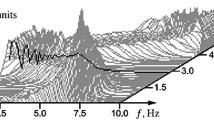Summary
Induced seismicity can be observed everywhere where the natural strain field of the earth's crust is changed through human influence, e. g. through mining, construction of cavities, storage of gas in rocks, injections of waste water, or hydrotechnical reservoirs. Such encroachments can release rock bursts, microearthquakes, or sometimes strong earthquakes. For the investigation of this type of seismic events, a modern mobile seismic array was developed. It consists of 6 high-sensitivity seismometer stations with radiotelemetry and one receiving and recording station installed in a measuring vehicle. In this vehicle, the seismic signals from the seismometer stations are received, selected, and recorded on cassette using the pulse code modulation method (PCM). The seismic signals are interpreted by means of a desk computer and a plotter.
A few minutes after recording a seismic event, one can compute and plot the location (epi- and hypocentre), energy (magnitude), and frequency distribution (histogram).
In an actual case of induced seismicity, information can be given very quickly by use of this special array. This information could be important for the safety of the construction. Examples are given in the paper.
Résumé
La séismicité provoquée peut être observée partout où le champ de tensions naturel de la croûte terrestre est modifié par une influence humaine, c'est-à-dire l'exploitation des mines, le creusement de cavités, l'accumulation de gaz dans les roches, l'injection d'eaux usées ou la construction de réservoirs hydrotechniques. De tels abus peuvent produire des éclatements de roches, des micro-séismes, voire quelquefois de forts séismes. Un ensemble séismique moderne et mobile a été mis au point pour l'étude de ce type de phénomènes séismiques. Il comprend six stations séismiques de grande sensibilité avec radiotélémètre et une station capteuse et enregistreuse installée sur un véhicule de mesure. Dans ce véhicule, les signaux séismiques des stations séismométriques sont reçus, triés et enregistrés sur cassette en utilisant la méthode PCM (pulse code modulation). Les signaux séismiques sont interprétés au moyen d'un ordinateur à console et d'un traceur de courbes. Quelques minutes après l'enregistrement d'un phénomène séismique, on peut calculer et tracer son emplacement (épicentre et hypocentre), son énergie (magnitude) et la répartition des fréquences (histogramme).
Dans un cas réel de séismicité provoquée, l'information peut être donnée très rapidement au moyen de cet appareillage spécial. Cette information pourrait être importante pour la sécurité de la construction. Des exemples en sont donnés dans l'article.
Similar content being viewed by others
References
Engineering Geology, 10, 1976.
GALANOPOULOS A. G. (1967): The large conjugate fault system and the associated earthquake activity in Greece.—Ann. Géol. Pays Helléniques, 18, 119–134.
GUPTA—RASTOGI (1976): Dams and Earthquakes.—Elsevier Scientific Publishing Comp., Amsterdam-Oxford-New York.
ROTHE J. P. (1968): Fill a lake, start an earthquake.—New Scientist 39, 605.
STEINWACHS M. (1971): Interpretation von Mikroerdbeben in Westgriechenland. (Interpretation of microearthquakes in Western Greece).—Journ. of Geoph., 37, 867–881, Würzburg.
STEINWACHS M. (1975): Seismological Investigations in the Area of the Ronnenberg Salt Mine in June 1975 (Seismologische Untersuchungen über dem Abbaugebiet der Kaligrube Ronnenberg im Juni 1975).—Report No. 69176, Geol. Survey of L. S., Hanover, F. R. Germany
Author information
Authors and Affiliations
Rights and permissions
About this article
Cite this article
Steinwachs, M. Studies of induced seismicity using a mobile radiotelemetric seismic array. Bulletin of the International Association of Engineering Geology 20, 128–131 (1979). https://doi.org/10.1007/BF02591263
Published:
Issue Date:
DOI: https://doi.org/10.1007/BF02591263




